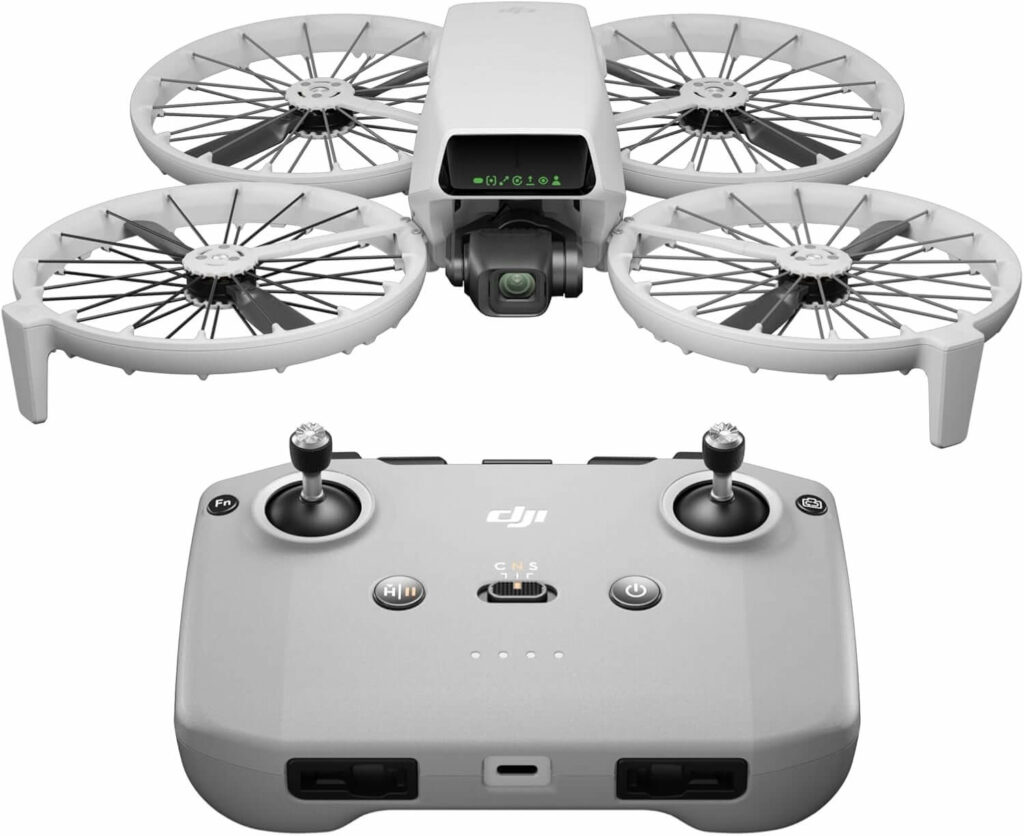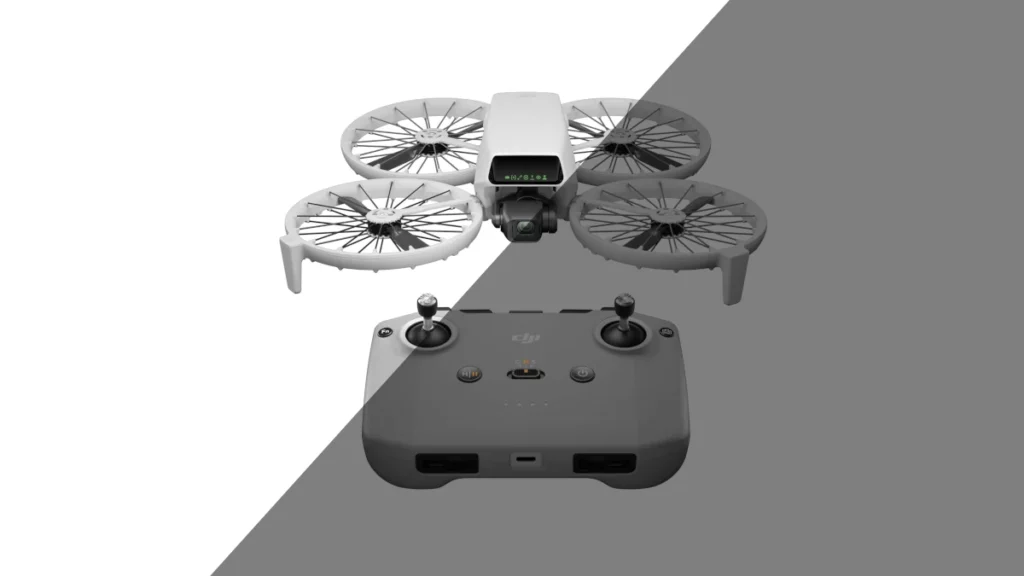DJI continues to push the boundaries of drone innovation with the DJI Flip, an inventive new model designed for content creators. With a first-of-its-kind folding structure and shrouded propellers for enhanced safety, this drone introduces fresh possibilities for aerial photography and videography. However, while it excels in portability and ease of use, some limitations—such as its obstacle tracking—leave room for improvement.
Key Features and Specifications
- Folding Propeller Design: A unique, space-efficient mechanism that enhances portability.
- Shrouded Propellers: Designed to improve safety for indoor and close proximity flying.
- High-Quality camera: 4K 60p video capability, borrowed from the mini 4 pro.
- Multiple Control Options: This can be flown using a controller, smartphone, voice commands, or a one-button launch.
- Extended battery life: Up to 34 minutes per charge in optimal conditions.
- Lightweight Construction: Weighing under 250g, allowing for permit-free operation.
- Limited Obstacle Avoidance: Features only forward and downward sensors.
DJI Flip Review: Design and Build
The DJI Flip sports a cutting-edge folding structure, where all four propellers tuck neatly beneath the body. This design improves portability and incorporates permanent shrouds around the propellers, enhancing safety by preventing accidental contact. The result is a drone that can be used confidently around people and in confined indoor spaces—ideal for vloggers, event professionals, and content creators.
DJI has prioritized weight reduction by integrating lightweight carbon fiber materials, keeping the Flip under the 250g regulatory threshold. However, this focus on portability comes at a slight cost: the drone is bulkier than some competitors, such as the sleek HoverAir X1 Pro.

Performance and Flight Experience
The DJI Flip delivers a respectable top speed of 26 mph in sport mode, though it lags behind the Mini 4 Pro’s 37 mph. Its relatively low weight and broad surface area make it vulnerable to strong winds. For instance, during testing over castle rooftops, gusts of wind pushed the Flip backward, requiring careful maneuvering.
That said, the Flip’s full propeller protection and stable flight mechanics allow for unique applications. Unlike traditional drones, it’s well-suited for filming in indoor spaces, crowded areas, and delicate environments where precision and safety are crucial.
Flight Modes and Smart Features
- Direction Track: Allows the drone to follow the subject from behind while maintaining stability.
- Automated Flight Patterns: Includes social media-friendly modes like Dronie, Rocket, Circle, Helix, and Boomerang.
- Hand Launching: With a simple button press, the Flip can take off from the palm of your hand.
Obstacle Avoidance Limitations
While DJI has incorporated forward-facing infrared sensors and downward vision detection, the Flip lacks side and rear obstacle sensors. This means users must remain vigilant when flying backward or in cluttered environments. Unlike the HoverAir X1 Pro, which offers full-direction obstacle tracking, the Flip requires manual intervention to avoid collisions.

DJI Flip Review: Camera and Image Quality
Equipped with a 1/1.3-inch 48MP sensor and a 24mm-equivalent f/1.7 lens, the Flip delivers excellent image quality comparable to the Mini 4 Pro. Users can capture:
- 4K video at 60 fps (with slow-motion support up to 100 fps)
- 10-bit D-LogM color profiles for enhanced dynamic range
- RAW photos (12MP or 48MP)
While the Flip’s camera performance is impressive, some trade-offs exist. Unlike the Mini 4 Pro, the Flip lacks a rotating gimbal, limiting vertical video resolution to 2.7K instead of 4K. Additionally, in smart flight modes, manual control over exposure settings is restricted.
Compared to its closest competitor, the HoverAir X1 Pro, the Flip offers slightly sharper and more color-accurate video. However, those requiring 8K 30fps or 4K 120fps will need to opt for the more expensive Pro Max version of the HoverAir.
DJI Flip Review: Battery Life and Connectivity
One of the Flip’s standout features is its 34-minute maximum flight time (approximately 27 minutes in real-world conditions), nearly doubling the endurance of the HoverAir X1 Pro. With an optional four-battery charger, users can quickly swap and recharge batteries within 35 minutes.
In terms of connectivity, DJI’s O4 transmission system ensures a robust eight-mile range with high-quality 1080p 60fps video transmission to the controller. However, when using a smartphone over Wi-Fi, the range is drastically reduced to 165 feet.
Who Should Buy the DJI Flip?
The DJI Flip is tailored for content creators, vloggers, and professionals seeking a safe, compact, and high-quality drone for both indoor and outdoor use. It excels in:
- Indoor event coverage where propeller safety is essential.
- Hand-launched vlogging with automated flight modes.
- Stable video recording in controlled environments.
However, those prioritizing subject tracking, full obstacle avoidance, or wind resistance may find better alternatives in the HoverAir X1 Pro or DJI’s more advanced models.
DJI Flip Review: Pros and Cons
Pros:
- Exceptional 4K video quality with a 48MP sensor.
- Foldable, shrouded design for enhanced safety.
- Excellent battery life for extended shooting sessions.
- Multiple smart flight modes for content creation.
- Permit-free operation under 250g weight limit.
Cons:
- Limited obstacle detection (only forward and downward sensors).
- Bulky compared to some ultralight competitors.
- Struggles in strong winds due to lightweight construction.
- No support for DJI Goggles or Motion Controllers.
Final Verdict
The DJI Flip represents a bold step forward in drone design, particularly for content creators. By prioritizing safety, portability, and intelligent flight modes, DJI has crafted a drone that unlocks new filming opportunities. At $439, it offers strong value for those needing a reliable, indoor-friendly, and high-quality video drone. However, professionals needing advanced obstacle tracking or extreme portability may find better alternatives in competing models.
DJI Flip Alternatives to Consider:
- DJI Mini 4 Pro: For higher wind resistance and superior tracking.
- HoverAir X1 Pro: For better subject tracking and compact portability.
- DJI Air 3S: For improved camera capabilities and flight performance.
For those prioritizing battery life, smooth video, and an intuitive flying experience, the DJI Flip remains an excellent choice.
Would you like to see real-world footage of the DJI Flip in action? Let us know in the comments!